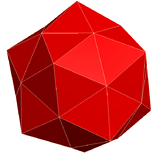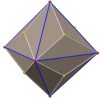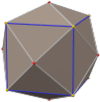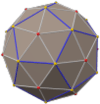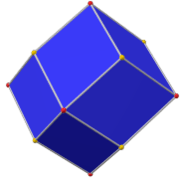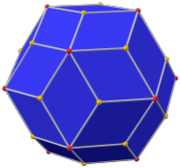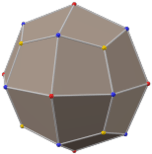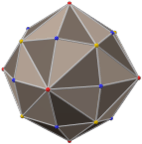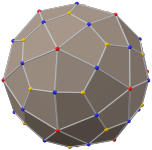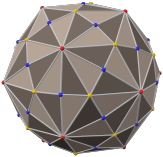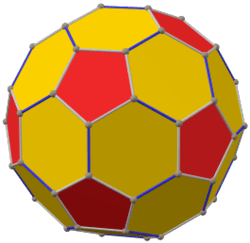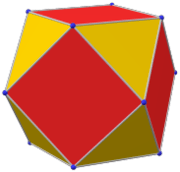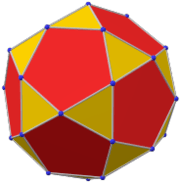Pentakis dodecahedron
| Pentakis dodecahedron | |
|---|---|
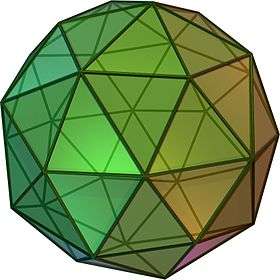 (Click here for rotating model) | |
| Type | Catalan solid |
| Coxeter diagram | |
| Conway notation | kD |
| Face type | V5.6.6 isosceles triangle |
| Faces | 60 |
| Edges | 90 |
| Vertices | 32 |
| Vertices by type | 20{6}+12{5} |
| Symmetry group | Ih, H3, [5,3], (*532) |
| Rotation group | I, [5,3]+, (532) |
| Dihedral angle | 156°43′07″ arccos(−80 + 9√5/109) |
| Properties | convex, face-transitive |
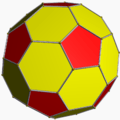 Truncated icosahedron (dual polyhedron) |
 Net |
In geometry, a pentakis dodecahedron or kisdodecahedron is a dodecahedron with a pentagonal pyramid covering each face; that is, it is the Kleetope of the dodecahedron. This interpretation is expressed in its name.[1] There are in fact several topologically equivalent but geometrically distinct kinds of pentakis dodecahedron, depending on the height of the pentagonal pyramids. These include:
- The usual Catalan pentakis dodecahedron, a convex hexecontahedron with sixty isosceles triangular faces illustrated in the sidebar figure. It is a Catalan solid, dual to the truncated icosahedron, an Archimedean solid. The critical height of each of the pyramids above the faces of the original unit dodecahedron is
- At this size, the dihedral angle between all neighbouring triangular faces is equal to the value in the table above. Flatter pyramids have higher intra-pyramid dihedrals and taller pyramids have higher inter-pyramid dihedrals.
- As the heights of the pentagonal pyramids are raised, at a certain point adjoining pairs of triangular faces merge to become rhombi, and the shape becomes a rhombic triacontahedron.
- As the height is raised further, the shape becomes non-convex. In particular, an equilateral or deltahedron version of the pentakis dodecahedron, which has sixty equilateral triangular faces as shown in the adjoining figure, is slightly non-convex due to its taller pyramids (note, for example, the negative dihedral angle at the upper left of the figure).
Other more non-convex geometric variants include:


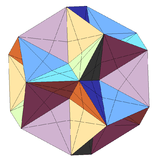
If one affixes pentagrammic pyramids into an excavated dodecahedron one obtains the great icosahedron.
If one keeps the center dodecahedron, one get the net of a Dodecahedral pyramid.
Chemistry

The pentakis dodecahedron in a model of buckminsterfullerene: each surface segment represents a carbon atom. Equivalently, a truncated icosahedron is a model of buckminsterfullerene, with each vertex representing a carbon atom.
Biology
The pentakis dodecahedron is also a model of some icosahedrally symmetric viruses, such as Adeno-associated virus. These have 60 symmetry related capsid proteins, which combine to make the 60 symmetrical faces of a pentakis dodecahedron.
Orthogonal projections
The pentakis dodecahedron has three symmetry positions, two on vertices, and one on a midedge:
| Projective symmetry |
[2] | [6] | [10] |
|---|---|---|---|
| Image |  |
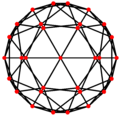 |
 |
| Dual image |
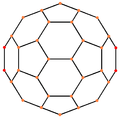 |
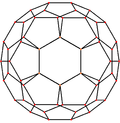 |
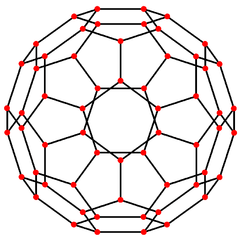 |
Related polyhedra
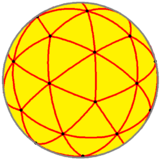
| Family of uniform icosahedral polyhedra | |||||||
|---|---|---|---|---|---|---|---|
| Symmetry: [5,3], (*532) | [5,3]+, (532) | ||||||
 |
 |
 |
 |
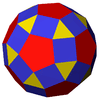 |
 |
 | |
| {5,3} | t{5,3} | r{5,3} | t{3,5} | {3,5} | rr{5,3} | tr{5,3} | sr{5,3} |
| Duals to uniform polyhedra | |||||||
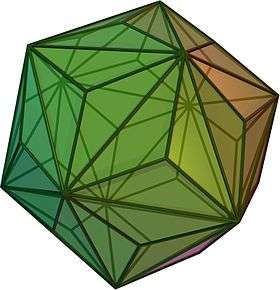 |
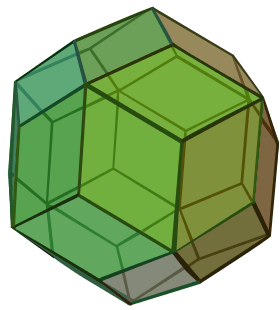 |
 |
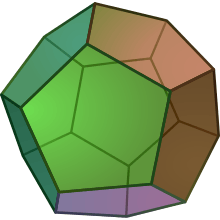 |
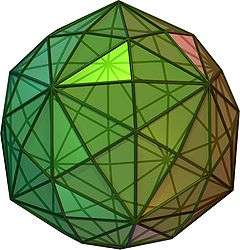 |
 | ||
| V5.5.5 | V3.10.10 | V3.5.3.5 | V5.6.6 | V3.3.3.3.3 | V3.4.5.4 | V4.6.10 | V3.3.3.3.5 |
| *n32 symmetry mutation of truncated tilings: n.6.6 | ||||||||||||
|---|---|---|---|---|---|---|---|---|---|---|---|---|
| Sym. *n42 [n,3] |
Spherical | Euclid. | Compact | Parac. | Noncompact hyperbolic | |||||||
| *232 [2,3] |
*332 [3,3] |
*432 [4,3] |
*532 [5,3] |
*632 [6,3] |
*732 [7,3] |
*832 [8,3]... |
*∞32 [∞,3] |
[12i,3] | [9i,3] | [6i,3] | ||
| Truncated figures |
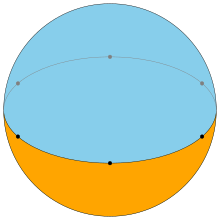 |
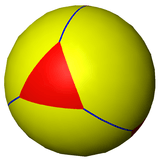 |
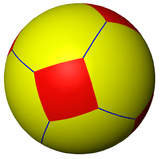 |
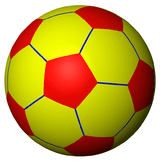 |
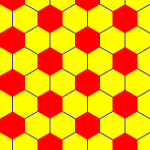 |
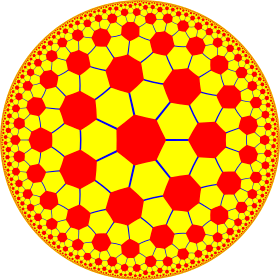 |
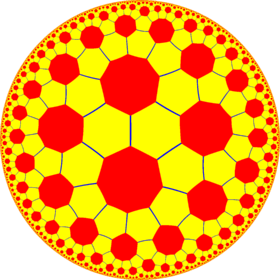 |
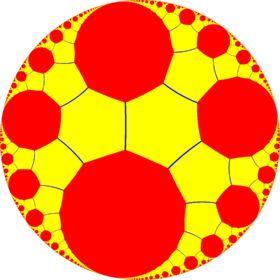 |
 |
 |
 | |
| Config. | 2.6.6 | 3.6.6 | 4.6.6 | 5.6.6 | 6.6.6 | 7.6.6 | 8.6.6 | ∞.6.6 | 12i.6.6 | 9i.6.6 | 6i.6.6 | |
| n-kis figures |
 |
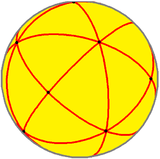 |
 |
 |
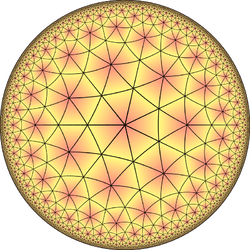 |
 |
 |
|||||
| Config. | V2.6.6 | V3.6.6 | V4.6.6 | V5.6.6 | V6.6.6 | V7.6.6 | V8.6.6 | V∞.6.6 | V12i.6.6 | V9i.6.6 | V6i.6.6 | |
Cultural references
- The Spaceship Earth structure at Walt Disney World's Epcot is a derivative of a pentakis dodecahedron.
- The model for a campus arts workshop designed by Jeffrey Lindsay was actually a hemispherical pentakis dodecahedron https://books.google.com/books?id=JD8EAAAAMBAJ&pg=PA92&dq=jeffrey+lindsay&hl=en&ei=oF88Tv25F7OisQLGwbwt&sa=X&oi=book_result&ct=result&redir_esc=y#v=onepage&q=jeffrey%20lindsay&f=false
- The shape of the "Crystal Dome" used in the popular TV game show The Crystal Maze was based on a pentakis dodecahedron.
- In Doctor Atomic, the shape of the first atomic bomb detonated in New Mexico was a pentakis dodecahedron.
- In De Blob 2 in the Prison Zoo, domes are made up of parts of a Pentakis Dodecahedron. These Domes also appear whenever the player transforms on a dome in the Hypno Ray level.
- Some Geodomes in which people play on are Pentakis Dodecahedra.
References
- ↑ Conway, Symmetries of things, p.284
- Williams, Robert (1979). The Geometrical Foundation of Natural Structure: A Source Book of Design. Dover Publications, Inc. ISBN 0-486-23729-X. (Section 3-9)
- Sellars, Peter (2005). "Doctor Atomic Libretto". Boosey & Hawkes.
We surround the plutonium core from thirty two points spaced equally around its surface, the thirty-two points are the centers of the twenty triangular faces of an icosahedron interwoven with the twelve pentagonal faces of a dodecahedron.
- Wenninger, Magnus (1983). Dual Models. Cambridge University Press. ISBN 978-0-521-54325-5. MR 0730208. (The thirteen semiregular convex polyhedra and their duals, Page 18, Pentakisdodecahedron)
- The Symmetries of Things 2008, John H. Conway, Heidi Burgiel, Chaim Goodman-Strass, ISBN 978-1-56881-220-5 (Chapter 21, Naming the Archimedean and Catalan polyhedra and tilings, page 284, Pentakis dodecahedron )
External links
- Eric W. Weisstein, Pentakis dodecahedron (Catalan solid) at MathWorld.
- Pentakis Dodecahedron – Interactive Polyhedron Model
